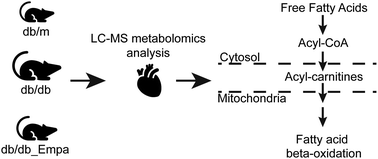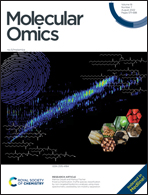Metabolomics study reveals the alteration of fatty acid oxidation in the hearts of diabetic mice by empagliflozin†
Abstract
Empagliflozin (Empa, SGLT2 inhibitor) is widely used in clinical situations for the management of diabetes. It has beneficial effects in reducing cardiac dysfunction and heart failure. However, rare studies have reported the potential mechanisms of Empa reaction. Here, we treated db/db diabetic mice with Empa and collected the heart tissue for metabolomics study. We found that db/db mice showed obvious differences in metabolomics profile compared with db/m mice. Many amino acid metabolism pathways and glycerophospholipids and fatty acyl carnitines were significantly enriched in db/db mice. Detailed analysis revealed the alteration of fatty acid oxidation in db/db mice. Interestingly, many metabolites in the fatty acid oxidation pathway, such as myristoleic acid, 12-hydroxydodecanoic acid, (15-carboxypentadecanoyl)carnitine, decanoylcarnitine, and propionylcarnitine, were significantly rescued by Empa treatment. These results suggest that fatty acid oxidation is one of the targets for Empa treatment in the heart of db/db mice. This study provided new possibilities for the development of therapeutic interventions for diabetic cardiomyopathy.



 Please wait while we load your content...
Please wait while we load your content...